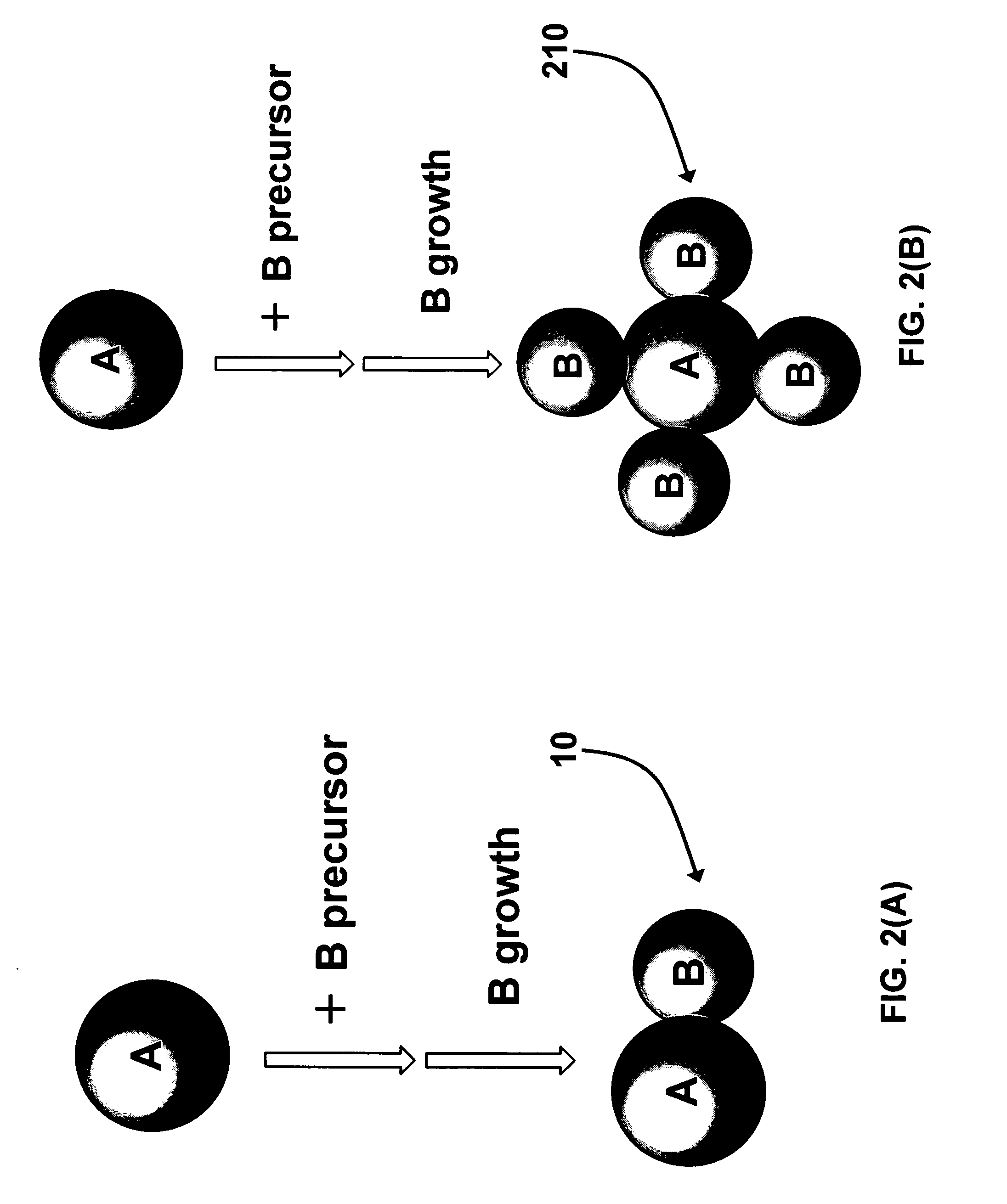Dumbbell-like nanoparticles and a process of forming the same
a nanoparticle and dumbbell technology, applied in the field of nanoparticle synthesis, can solve the problems of inconclusive evidence of au coating over a magnetic nanoparticle, large size, and unsuitability for biomedical applications
- Summary
- Abstract
- Description
- Claims
- Application Information
AI Technical Summary
Benefits of technology
Problems solved by technology
Method used
Image
Examples
example 1
[0056] Direct synthesis of A-B dumbbell-shaped particles 10 as described in Scheme 1 with A comprising 12 nm PbSe and B comprising 8 nm Au nanoparticles. 100 mg HAuCl4.3H2O (0.25 mmol), 2 mL oleylamine (6 mmol), and 0.7 mL oleyl acid (2 mmol) are added to a hexane dispersion of PbSe nanoparticles (100 mg PbSe in 20 ml hexane). The solution is heated at 40° C. for 1 hour. The PbSe—Au dumbbell-shaped nanoparticles 10 are then separated from solution by adding ethanol and centrifugation. The particles are re-dispersed in any of the following organic solvents including toluene, hexane, butyl ether, etc. Similarly, various A-B dumbbell-shaped nanoparticles can be made with “A” comprising any of semiconducting PbS, CdSe, CdS, etc, and “B” comprising any of Au, Ag, Pt, and Pd.
example 2
[0057] General synthesis of A-B dumbbell-shaped particles as described in Scheme 1 with A comprising 6 nm Au and B comprising 12 nm Fe2O3 nanoparticles. 8 nm Au nanoparticles are formed by dissolving 1.0 g HAuCl4.3H2O in a solution of oleyl amine (10 ml) in Toluene (100 ml) and heated to 80° C. for 2 hours. The gold nanoparticles are then separated from solution by adding ethanol and centrifugation. Au—Fe2O3 dumbbell-shaped particles with Au comprising 8 nm Au and Fe2O3 comprising 15 nm are formed by injecting 0.14 ml Fe(CO)5 (1 mmol) into a solution of oleyl acid (1.0 ml, 3 mmol) in 20 ml octadecene at 130° C. The solution is retained at this temperature for 10 min before 1 ml hexane dispersion of gold nanoparticles (10 mg Au nanoparticles in 1 ml hexane) is added then, the solution is brought up to 300° C. for 1 hour. To convert the iron completely to Fe2O3, the solution is bubbled through oxygen at 200° C. for 1 hour. The dumbbell-shaped nanoparticles are then separated from sol...
example 3
[0058] General synthesis of A-B nanoparticles 210 as described in Scheme 2. Au—Fe2O3 flower-like nanoparticles 210 with “A” comprising 8 nm Au and “B” comprising 10 nm Fe2O3. 0.14 ml Fe(CO)5 (1 mmol) is injected into a solution of oleyl acid (1.0 ml, 3 mmol) in 20 ml phenyl ether at 110° C. The solution is retained at this temperature for 5 min before 1 ml hexane dispersion of gold nanoparticles (10 mg Au nanoparticles in 1 ml hexane) is added, and the solution is then brought up to reflux for 3 hours. To convert the iron completely to Fe2O3, the solution is bubbled through oxygen at 200° C. for 1 hour. The flower-shaped nanoparticles 210 are then separated from solution by adding ethanol and centrifugation. The nanoparticles 210 are re-dispersed in any of the following organic solvents such as toluene, hexane, butyl ether, etc.
PUM
| Property | Measurement | Unit |
|---|---|---|
| reaction temperature | aaaaa | aaaaa |
| temperature | aaaaa | aaaaa |
| size | aaaaa | aaaaa |
Abstract
Description
Claims
Application Information
 Login to View More
Login to View More - R&D
- Intellectual Property
- Life Sciences
- Materials
- Tech Scout
- Unparalleled Data Quality
- Higher Quality Content
- 60% Fewer Hallucinations
Browse by: Latest US Patents, China's latest patents, Technical Efficacy Thesaurus, Application Domain, Technology Topic, Popular Technical Reports.
© 2025 PatSnap. All rights reserved.Legal|Privacy policy|Modern Slavery Act Transparency Statement|Sitemap|About US| Contact US: help@patsnap.com



